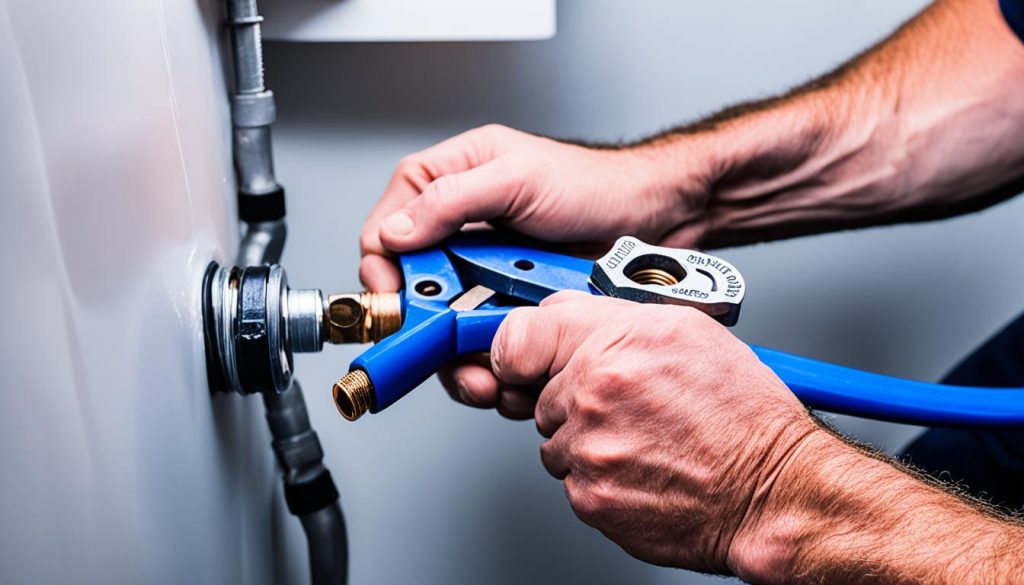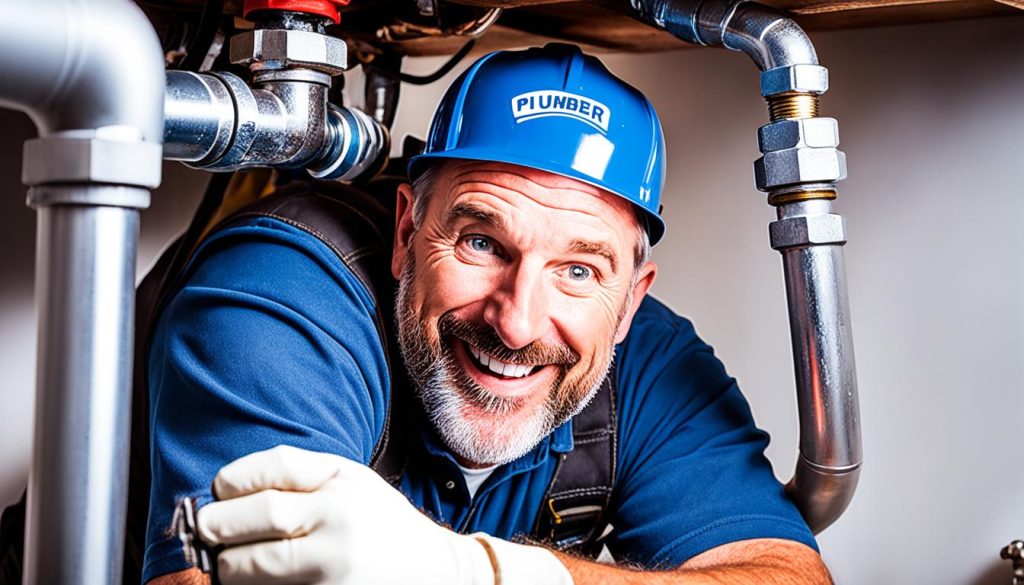Understanding Unions in Plumbing – Key Uses & Types
Did you know that a secure and semi-permanent connection between two pipes in plumbing can be achieved through the use of a pipe union? This small but powerful fitting plays a crucial role in plumbing systems, providing easy assembly, disassembly, and positive sealing for a variety of applications.
Key Takeaways:
- A pipe union is a fitting that creates a secure and semi-permanent connection between two pipes.
- It consists of a male end, a female end, and a nut, which seal the joints together.
- Two common types of pipe unions are ground joint unions and flange unions.
- Unions are used in non-hazardous and non-flammable services such as fire protection systems, water and wastewater piping systems, and plumbing applications.
- Using unions in plumbing offers benefits such as leak-proof disconnection points, easy maintenance and repair, and versatility in joining pipes of different sizes.
Types of Unions in Plumbing
When it comes to plumbing applications, there are two main types of unions that are commonly used: ground joint unions and flange unions. Each type has its own unique characteristics and benefits, making them suitable for different plumbing needs.
Ground Joint Unions
Ground joint unions are designed with an angled cut to increase the joint surface area, ensuring a better seating between the pipes. These unions consist of three pieces: a male end, a female end, and a nut. The male and female ends are sealed together in the nut, creating a secure and semi-permanent connection. Ground joint unions are widely used in plumbing services where easy assembly, disassembly, and positive sealing are required.
Flange Unions
Flange unions, on the other hand, utilize a pair of flanges to hold two pipes securely together. These flanges are screwed on the ends of the pipes, creating a strong connection. Flange unions are commonly used in plumbing services to join pipes that require a more secure connection.
Both ground joint unions and flange unions can be either threaded or socket welded, depending on the joint connection. They are available in various materials, including metallic ones that are preferred in piping industries and plastic ones that are commonly used in plumbing services.
Having a good understanding of the types of unions in plumbing can help you make informed decisions when it comes to your plumbing projects. Whether you need easy assembly and disassembly or a secure connection, there’s a union fitting that suits your needs.
How Do Plumbing Unions Work?
Plumbing unions play a crucial role in creating secure connections between two pipes without causing any deformation. These unions consist of three key components: a male end, a female end, and a nut. The male and female ends are threaded, and when these ends are sealed together using a nut, a tight joint is formed. This ensures a leak-free connection and prevents any potential water or gas leakage.
One of the key advantages of plumbing unions is their ability to be easily disconnected when necessary. When maintenance or repair work is required on a specific section of a piping system, the nut can be unscrewed, allowing the pipes to be conveniently separated. This saves time and effort compared to traditional methods of cutting and rejoining pipes.
To install a union in plumbing, the male and female ends of the union are screwed onto the respective pipes. The nut is then tightened to provide the necessary sealing pressure, ensuring a secure connection. The installation process is relatively simple and can be done by professionals or experienced individuals.
Plumbing unions are widely used in various plumbing applications where easy assembly, disassembly, and positive sealing are required. They are commonly found in residential and commercial buildings, as well as in industrial settings. By incorporating unions into plumbing systems, maintenance and repair work become more efficient and cost-effective.
Overall, plumbing unions are essential components in plumbing systems, providing a reliable and flexible solution for connecting and disconnecting pipes. Their functionality and ease of use make them a popular choice in the plumbing industry.
Below is a table summarizing the key features and benefits of plumbing unions:
| Features | Benefits |
|---|---|
| Secure connection | Prevents leakage and ensures efficient flow |
| Easy disconnection | Facilitates maintenance and repair work |
| Simple installation | Reduces time and effort |
| Flexible application | Can be used in various plumbing systems |
| Durable and reliable | Long-lasting performance |
Benefits of Using Unions in Plumbing
Using unions in plumbing systems comes with a range of benefits that enhance both functionality and convenience. Let’s explore some of the key advantages:
- Leak-proof disconnection point: Unions provide a secure disconnection point in any piping system, ensuring a leak-proof seal. This makes maintenance and repair work much easier and efficient, minimizing downtime and potential water damage.
- Integration of metering and regulating devices: Unions are commonly used to connect metering and regulating devices into plumbing applications. Their versatility allows for easy installation and adjustment of these devices, ensuring optimal performance.
- Facilitating connections to vessels: With their ability to connect piping systems to vessels, unions enable smooth and reliable flow of liquids or gases between different components. This is crucial in applications such as water treatment systems and industrial processes.
- Joining pipes of different sizes: Unions offer the ability to join pipes of different sizes, providing flexibility in plumbing systems. This allows for easy adaptation to changing requirements and simplifies installations where multiple pipe sizes are involved.
Moreover, the installation process for unions is straightforward, minimizing labor and time costs. Their economical pricing makes them a cost-effective choice for plumbing systems without compromising on quality and durability.
Overall, the importance of unions in plumbing systems cannot be understated. They play a vital role in ensuring secure, efficient, and flexible connections between pipes, enabling smooth operation and easy maintenance.
Key Benefits of Using Unions in Plumbing
| Benefits | Description |
|---|---|
| Leak-proof disconnection point | Provides a secure seal for easy maintenance and repair |
| Integration of metering and regulating devices | Allows easy installation and adjustments |
| Facilitating connections to vessels | Enables smooth flow between piping systems and vessels |
| Joining pipes of different sizes | Offers flexibility to adapt to varying pipe size requirements |
With these benefits in mind, it is clear that unions are indispensable components in plumbing systems.
Union vs Coupling in Plumbing
When it comes to joining pipes in plumbing, two common options are unions and couplings. While they serve a similar purpose, there are distinct differences between the two.
A coupling is primarily used for permanently joining pipes or connecting a pipe to a swedge. It creates a strong, permanent connection that is suitable for various plumbing applications. On the other hand, a union is specifically designed for easy disassembly and reassembly of a part of a piping system. Unions provide a convenient way to disconnect pipes without having to unscrew the entire system, making them ideal for maintenance or replacement purposes.
Another difference between unions and couplings is their typical usage. Couplings are commonly used for lengthening a pipeline or connecting pipes of the same size. They are particularly useful in situations where a rigid connection is needed. Unions, on the other hand, are frequently employed in plumbing systems where certain parts require frequent maintenance or repair. Their ability to be disconnected and reconnected easily makes them invaluable in such scenarios.
It’s worth noting that couplings are often used in high-pressure services, where a secure and reliable connection is essential. Unions, on the other hand, are predominantly used in low-pressure occasions, where the focus is on convenience and ease of disassembly. Additionally, the cost of unions is typically higher compared to couplings, owing to their design and functionality.
Source Links
- https://whatispiping.com/pipe-union/
- http://www.thepipefittings.com/pipe-union.html
- https://www.pipesandfittings.com/pipe-coupling-vs-union.html
- Investing Wisely: How Windows & Doors in Boost Property Value and Financial Health - April 24, 2025
- The Financial Impact of Personal Injuries: Why Legal Help Matters for Business Owners - April 16, 2025
- The Hidden Financial Costs of Domestic Assault: What Business Owners Need to Know - April 16, 2025













